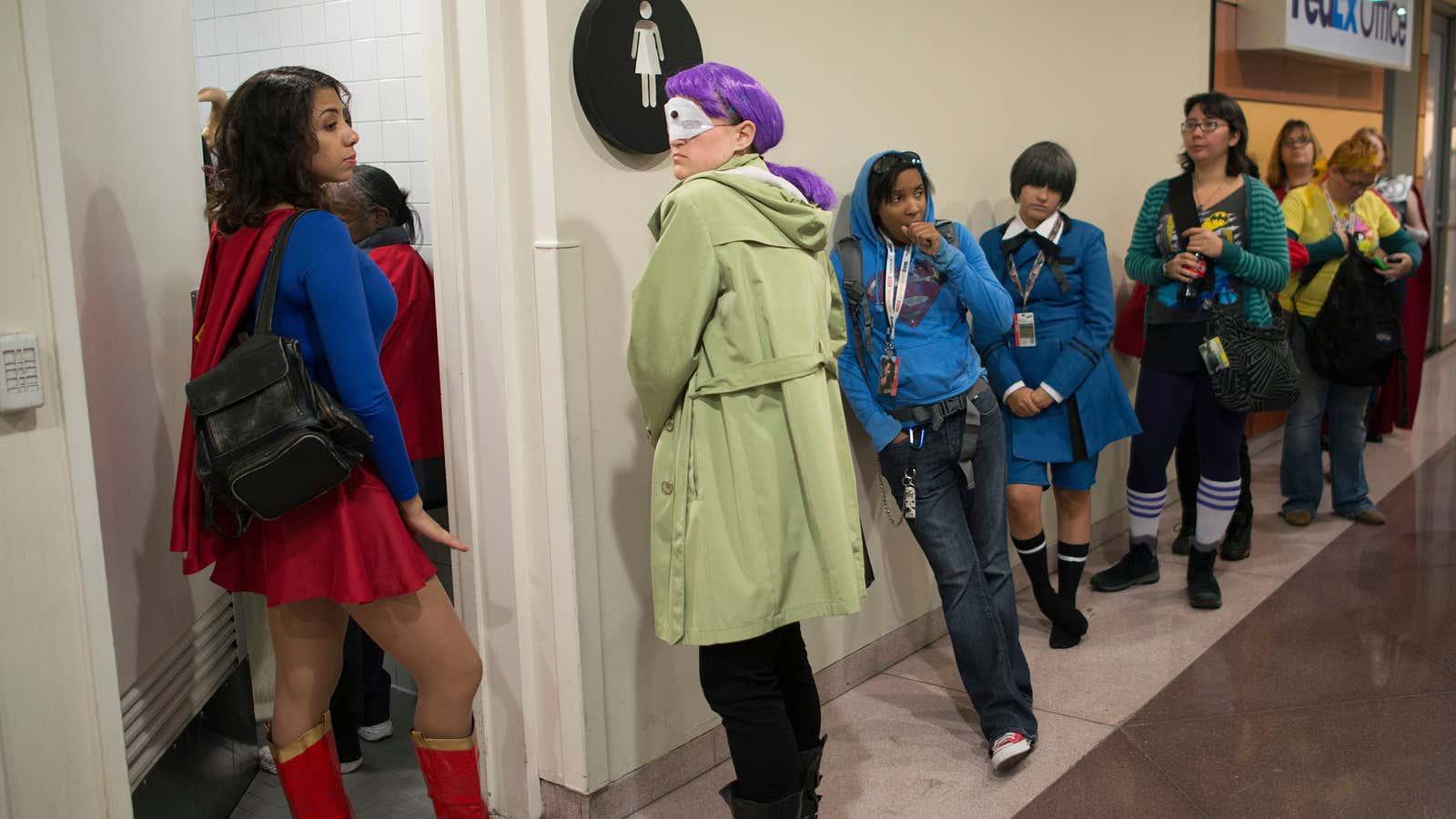As a woman, waiting in long lines for public restrooms is second nature. So you can imagine my surprise when I walked into an empty women’s bathroom at AWS: reInvent, Amazon’s cloud-services conference, two years ago. Normally I’d consider this a win, but knowing the conference has more than 40,000 attendees, it raised a bigger question: If all the women are missing from the restroom, where else is their presence lacking at these events?
I took to Twitter to post a picture of the barren room. It wasn’t long before other women replied with their own pictures of queue-less tech-conference bathrooms and stories of similar encounters. But the conversation didn’t stop there.
Captivated by this realization, I decided to dig deeper. I already knew that there was a long history of gender inequality at tech conferences around the world. From robot strippers to booth babes, the tech industry’s sexist reputation was painstakingly clear. But as discouraging as it was to read these headlines, we felt they didn’t paint the whole picture—so we took it upon ourselves to finish filling in the blanks.
Ensono conducted a study, “Speak Up: Bringing More Women’s Voices to Tech Conferences,” to take an objective look at the experiences and perceptions of women at tech conferences. We surveyed 500 women across the US and UK who have attended a tech conference, and audited 18 global tech conferences to uncover the ratio of male to female keynote speakers over the last three years. Some of the results were as we expected, and some were surprising, but they all reveal an issue that businesses in the tech industry can do more to solve.
Here’s a breakdown of our biggest takeaways:
- 70% of women who’ve sat on a panel at a technology conference have been the only woman on the panel. Although it’s great to see women on stage, it’s significantly less often than men. (It’s so common to have male-only sessions that they’ve become known as “manels.”) From 2016 to 2018, we found 11 instances where keynote speaker lineups were completely devoid of female speakers, including at CES, Trustech, and Digital Enterprise Show. The “lone” woman on a panel trend may be a result of a genuine effort for inclusion, but it ends up looking a lot more like tokenism.
- One in four women have experienced sexual harassment at a tech conference. In the wake of the #MeToo movement, we’ve witnessed progress in this area, but the numbers don’t lie. The tech industry has been widely known for having a Boys’ Club atmosphere—like women dressed in body paint at exhibitor booths—and more than one-third (31%) of respondents have witnessed that.
- Only 25% of tech-conference keynotes in the last three years were women. Although I’d like to see a higher ratio than 1:4 female to male keynote speakers, this statistic is relatively in line with the ratio of women to men in technology roles in the industry. However, to build the pipeline of female tech talent and bridge that ratio, we need more exposure to female leaders who are pioneering the way. And that can start on the keynote stage. Seventy-six percent of respondents told us they are more likely to attend a tech conference if it includes female speakers or programming geared toward women.
- Seventy-four percent report attending tech events without nursing rooms. Not only is there an absence of women at these events, but there is also a lack of accommodations for women, especially mothers. Packing up for a week to fly out to a conference is out of the question for most moms, setting women’s opportunity to speak at or attend industry events far apart from their male colleagues. Conferences need to consider the accommodations women and mothers need that could significantly improve their experience, like mother’s rooms and on-site childcare.
- Nearly half (49%) of respondents have not seen a code of conduct at any conference they’ve attended. We found that half of the conferences audited don’t have a code of conduct for attendees, and nearly every conference that does has it buried on their site. A code of conduct should be mandatory and easily accessible to every attendee, regardless of gender. This sends a clear message for how certain behaviors or actions will not be tolerated and will be handled in an official manner.
- There was a 4% increase in the number of female speakers in tech conference lineups from 2016 to 2018. It’s not a steep slope, but it’s proof we’re moving in the right direction. More women are sitting in the C-suite and filling conference halls, but we need more actions taken by tech companies if we want to see a higher and faster growth rate.
Although it’s easy to use conference organizers as scapegoats for these gender-gap issues, the decision-makers at tech companies across the globe share the responsibility. By looking internally at their workforce and encouraging more of their female associates to attend and speak at industry events, business leaders can be part of the solution. Offering the right training and support are small initiatives that can make a big impact.
So let’s build a line out the door for women’s bathrooms at tech conferences—it’s a small price I’m more than willing to pay.
